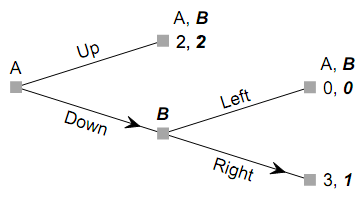Game 1 Color Coordination (with Delay)

This game should be played twice, once without the delay tactic and once with it, to show the difference between out- comes in the simultaneous and sequential versions. As usual, the game can be played by pairs of students, although it can also be played by all students simultaneously with the left- hand side of the room's playing against the right-hand side. Tell the students not to write down anything (except their names) until they hear all of the instructions. As with the tacit coordination game, you might want to provide some inducement for coordination here; chocolate usually works well.
Ask the students to choose partners from the other side of the room or have them imagine that each is playing with one person who is sitting on the other side of the room. Each student will eventually be asked to write either pink or purple. If both students in the real or imaginary pair write pink, the person on the right-hand side of the room gets 50 points and the person on the left-hand side of the room gets 40 points. ("Right-hand" and "left-hand" are defined from the students' point of view.) If both write purple, the person on the left- hand side of the room gets 50 points and the person on the right-hand side of the room gets 40 points. If the answers don't match, neither player gets anything.
To play without the delay tactic, simply ask the students to choose a color and write the choice. Then play again, im- mediately, but explain that you will flip a coin first. If it comes up heads, those on the right-hand side of the room get to write their answers first; otherwise those on the left-hand side of the room write first.
Once you have collected answers from the students, you can discuss the implications of the game. Clearly, it is much more difficult to coordinate without the benefit of the delay tactic and there are two equilibria in pure strategies in the simultaneous-move game. The delay tactic makes the game sequential and creates a first-mover advantage; outcomes from this version often come much closer to complete co- ordination. As usual, you can ask students to try to come up with real-world situations that replicate some of the conditions of the game, or you can provide some examples.